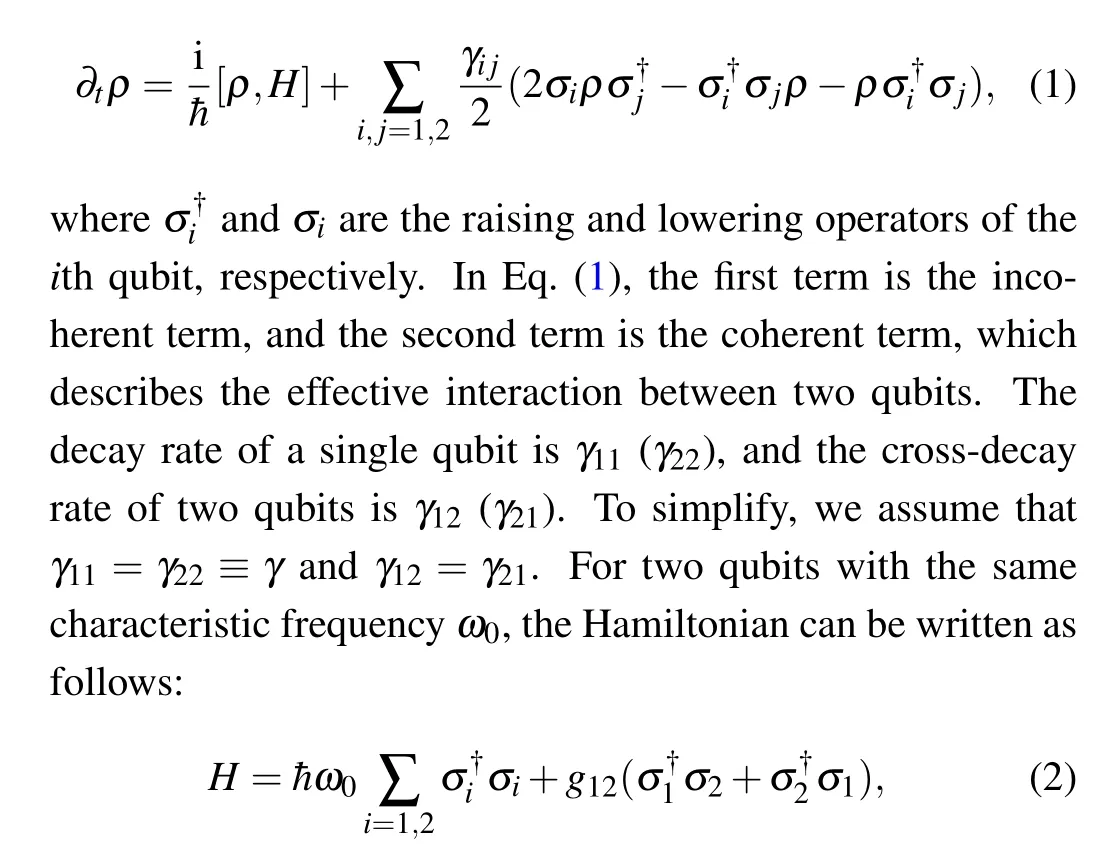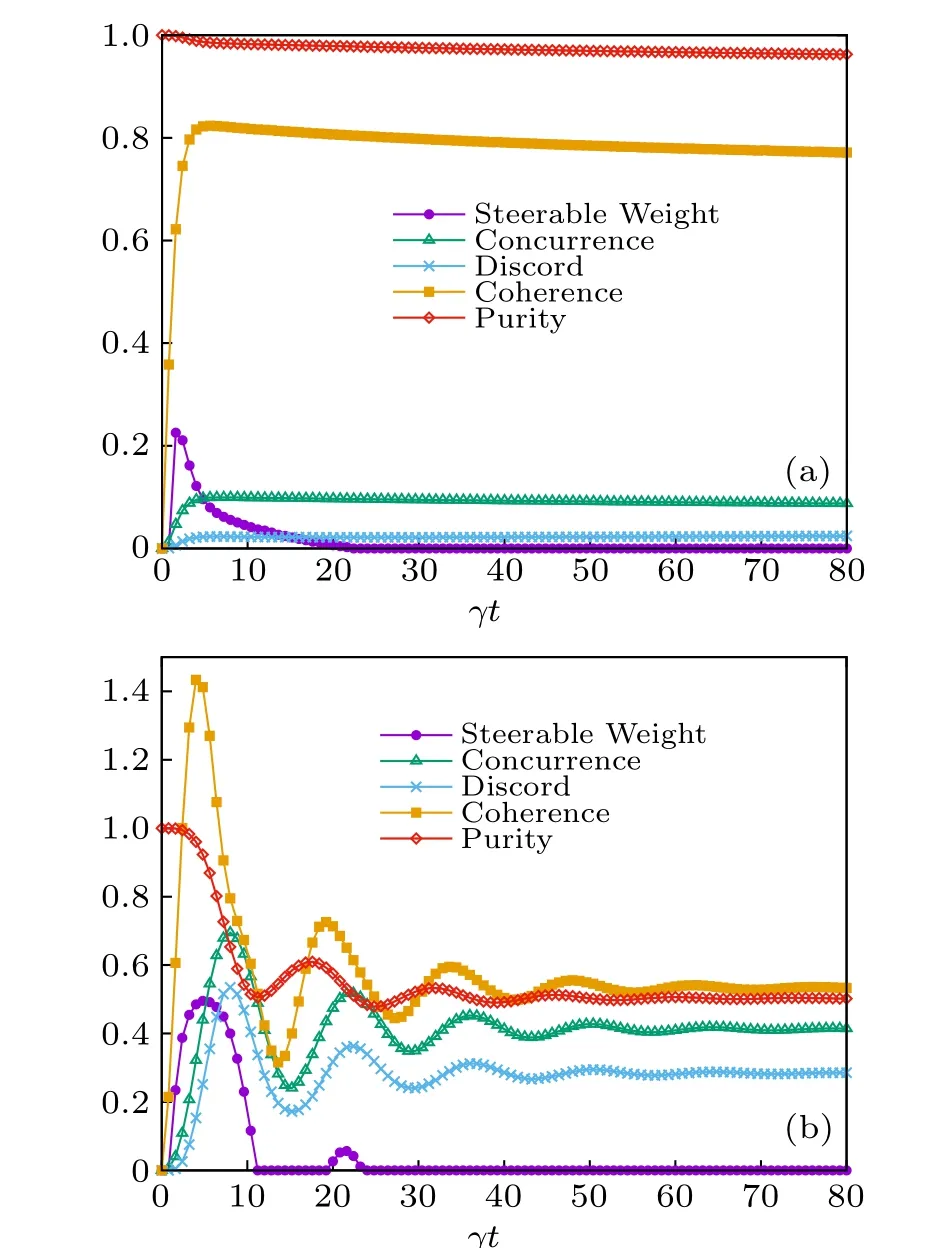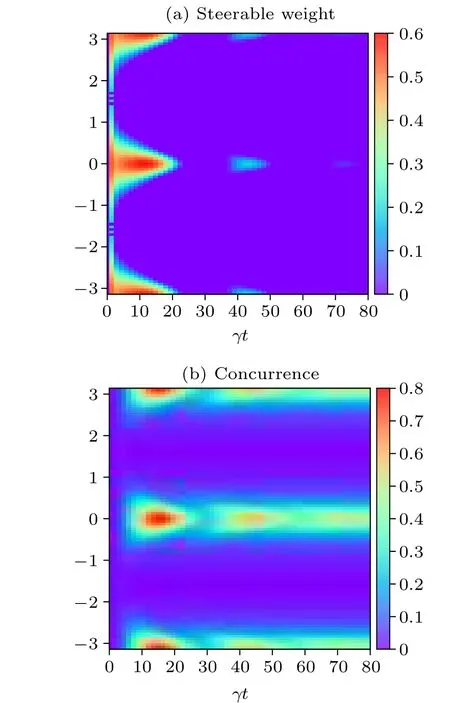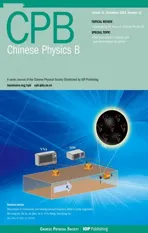Quantum steerability of two qubits mediated by one-dimensional plasmonic waveguides
2022-12-28YeQiZhang张业奇XiaoTingDing丁潇婷JiaoSun孙娇andTianHuWang王天虎
Ye-Qi Zhang(张业奇) Xiao-Ting Ding(丁潇婷) Jiao Sun(孙娇) and Tian-Hu Wang(王天虎)
1Department of Mathematics and Physics,North China Electric Power University,Beijing 102206,China
2School of Energy Power and Mechanical Engineering,North China Electric Power University,Beijing 102206,China
Keywords: quantum steering,quantum correlations,plasmonic waveguide
1. Introduction
Steering, firstly proposed by Schr¨odinger,[1]is a quantum effect that a distant part can remotely prepare ensembles of quantum states by performing local measurements with the aid of entanglement. It allows one to certify the presence of entanglement between a device-untrusted part and a device-trusted part.[2,3]Due to the fact that certification of entanglement[4]requires quantum measurements on both sides, whereas in Bell nonlocality,[5]both parts possess untrusted black-box devices, steering can be treated as a type of quantum correlation situating between entanglement and Bell nonlocality. Several experiments,[6–10]including steering without Bell nonlocality[11]and a fully loop-hole free steering demonstration,[12]have verified the steering phenomenon.Like entanglement, quantum steering has been regarded as a quantum resource.[13]It plays an important role in the onesided device-independent quantum key distribution (1S-DIQKD), where only one of the parts has an untrusted device while the other ones possess the trusted apparatus.[14,15]The 1S-DI-QKD has the advantage that its experimental requirements for unconditionally secure keys are less rigorous than those in both-sided DI-QKD.[16]Besides, it is found recently that quantum steering can also be used to demonstrate network steering[17]and can be observed on IBM quantum computers.[18]
On the other hand, the realization of establishing longdistance nonclassical correlations (between two nodes of a quantum network), especially in dissipative environments, is crucial for quantum information processing.[19]It has been reported that photons can be used as a medium to set up entanglement between two qubits.[20,21]Meanwhile, several proposals for mediating long-distance quantum correlations of two nodes by using plasmons have attracted considerable interest.[22–29]Plasmons traveling along a surface are known as surface plasmon polaritons which can be typically excited by light waves striking on a metal surface.[30]Since plasmons display a strong local surface effect, it is effective for breaking the classical diffraction limit and manipulating light in the nanoscale domain. It was shown that the spontaneous formation of a high degree of entanglement can be acquired, even for the separation of subsystems are larger than the operating wavelength.[31]With the development of nanotechnologies,strong and efficient coupling in plasmonic quantum electrodynamics is attainable and plasmons become a possible candidate for quantum information science.[32–35]
城隍庙东,有初等女学堂,在堂肄业之女学生三四十人。堂之规模不甚宏壮,其门联云:许多别径旁门休轻着走,不到升堂入室莫漫回头。初等小学堂设文庙之侧,中等学堂在府署之东,黄公祠内设西河书院改为高等学堂。……实业有限公司设立东大街,面目宏丽,维新气象咄咄逼人。府城风气之开,较之县城为早。[10]
In this paper, we investigate the dynamics of quantum steering between two separated qubits which are modulated by a one-dimensional plasmonic waveguide. Staring from the master equation that governs the dissipative dynamics of the two qubits for arbitrary initial states,we numerically calculate the quantum steerability using the semidefinite program. It is shown that the dynamical behavior is largely dependent on the plasmon wavenumber and the distance between the two qubits.By comparing with quantum entanglement,discord and coherence,we find quantum steerability is more fragile under dissipative environments. In particular,steerability would undergo sudden disappearance and sudden reappearance processes. It is found that there exist time windows with zero steerability but finite entanglement for the system. The features of fixed and random direction measurement protocols on steerability are also examined. In order to tune the dynamical behavior of steerability,classical fields for driving could be locally applied to the qubits. We demonstrate that under continuous driving,time duration with finite steerability can be enlarged remarkably.
其中,vce为弹体完全销蚀的临界速度; 对于45#钢弹侵彻半无限混凝土靶板, vce为2 380 m·s-1。
2. Two qubits mediated by a one-dimensional plasmonic waveguide
In this paper, we consider identical qubits trapped in a V-shaped one-dimensional plasmonic waveguide (1D-PW).Usually, surface plasmon polaritons dissipate due to the internal losses in the metal and the radiation losses. Hence,waveguides are needed to confine and direct the propagation of surface plasmon polaritons with minimal energy loss.[36]Metallic structured waveguides can display strong field concentration and it has been shown that a one-dimensional Vshaped channel is more efficient for establishing entanglement than a cylinder nanowire.[31]Moreover, the V-shaped waveguide stands out as a competitive structure as it can promote a large coupling efficiencyβdue to the strong EM confinement it offers.[37]The V-shaped 1D-PW has a V-groove structure that is milled on a silver film. As shown in Fig. 1, the two qubits are placed symmetrically along the direction of the plasmonic waveguide with a distance ofd. To ensure that the two qubits are equally influenced by the 1D-PW,their vertical distances from the surface are all set to beh. With considering the spontaneous emission of qubits, the dynamic density matrixρof two qubits can be obtained by the following master equation:[38,39]

CC(ρ)=S(ρA)−min{Bj}∑j pjS(ρj).


wherekplandLare the wavenumber and propagation length of plasmon, respectively.kplis related to the mode wavelengthλplof the plasmon, that is,kpl·λpl=2π. The key point of Eq.(3)is that theπ/2 phase shifts between coherent and incoherent phases of coupling. As we will see below,it can change one of the two contributions and maximize the other contribution by adjusting the distance between the qubits,thus opening the possibility of modulating the degree of quantum correlations.

Fig.1. Schematic diagram of the interaction between a two-qubit system and a one-dimensional plasmonic waveguide with V-shaped structure.
As comparative quantum correlations,to explore the significant properties of quantum steering in studying the plasmonic waveguide model,we calculate the entanglement,quantum discord, and coherence as comparative quantities. They have been widely used to measure quantum correlations in other systems. Here we briefly introduce their definitions.Concurrence,[44]as a measure of quantum entanglement, for two-qubit states,the following results can be obtained:

which satisfiesρ1+ρ5+ρ8+ρ10=1.The dynamics matrix is written in the basis|1〉=|g1,g2〉,|2〉=|g1,e2〉,|3〉=|e1,g2〉,and|4〉=|e1,e2〉. Substituting Eq. (4) into Eq. (1), we obtain the differential equations for the non-zero elements of the density matrix as follows:


3. Quantum steering and other correlations
为此,我概括了班主任语言的“五有”:有思想、有温度、有趣味、有文采、有智慧。只有这样,才能将班级精神推向进取、科学、超越的高地。
A steering experiment therefore can be fully characterized by giving an assemblage{σa|x}ax,which is a set of nonnormalized states Alice steers Bob into, given her choice of measurementxand the corresponding outcomea. The assemblage encodes the conditional probability distribution of the Alice result from the given input,p(a|x)=Tr(σa|x), and the conditional state for Bob ˆσa|x=σa|x/P(a|x). All valid assemblages meet consistency requirements

In the following, we consider the scheme of tuning quantum steerability by locally applying two classical fields.Under the condition of continuous drivings, a new term∑i=1,2Ωi(σ†i+σi) should be added to the effective Hamiltonian given in Eq. (2), whereΩiis the coupling strength between thei-th qubit and its classical field with frequencyωc.Here,we consider three different driving conditions:(i)asymmetric driving (Ω1/=0,Ω2=0); (ii) antisymmetric driving(Ω1=−Ω2/=0)and(iii)symmetric driving(Ω1=Ω2/=0).For simplicity, we consider the same initial state|e1,e2〉and¯β=0.99 in all below cases.

whereλis the classical random variable held by Alice,Dλ(a|x)are deterministic single party conditional probability distributions for Alice,andσλis the state held by Bob.We call such an assemblage unsteerable and the set of unsteerable assemblages is represented byΣUS. Any assemblages that cannot be written in Eq. (7) constitutes a genuine resource in a steering scenario and is called steerable. The set of steerable assemblage is represented byΣS. Using the semidefinite program(SDP),[42]we can test whether a given assemblage is in a set of unsteerable assemblage,i.e.,if{σa|x}ax ∈ΣUS.
Here,we adopt the steerable weight(SW)introduced by Skrzypczyket al.[43]as a measure of steerability for a bipartite state. The main ideas behind the SW are as follows. When preparing a given assemblage, Alice should reduce the number of uses of real steering resources and prepare as frequently as possible an unsteerable assemblage. In other words,we decompose the assemblage into

The general form of density matrix for two quantum element systems is
Another useful quantum resource is the coherence and we adopt the relative entropy of coherence[46]as the measure for the stateρ

whereM(ρ)=S(ρA)+S(ρB)−S(ρ),ρA(ρB) is the reduced density matrix of subsystemA(B)of the compound bipartite systemAB, andS(ρ) is the von Neumann entropyS(ρ) =−trρlog2ρ. The classical correlations can be defined by using Von Neumann type measurements. Consider a complete set of orthogonal projectors{Bj}to describe the projection measurements only acts on systemB. The condition matrix associated with the measurement resultjisρj=(1⊗{Bj})ρ(1⊗{Bj}),where 1 is the identity matrix of subsystemAand the probability of obtaining the measurement resultjispj= tr[(1⊗{Bj})ρ(1⊗{Bj})]. The total classical correlations are defined as the following superior limit
where coherent dipole–dipole coupling rate is expressed byg12. It was found that when the propagating plasmon is the main channel of emission(i.e., the largeβfactor, which represents the fraction of emitted radiation captured by the propagation model),a good approximation of the total Green’s function can be obtained.[40]In this way,the analytical expressions ofg12andγ12can be derived
柳含烟认为萧飞羽不仅搞错了当初在马车上露脸的是谁,从那“傲慢得要命的丫头”该是唤起的模糊印象也是她多么年幼无知,以致错上加错搞混了她和白雪,又由于为她解穴时发现她非处子才说:“如果你不是名花有主我一定不会放过你。”也因为他认为她稚气无知才会有意外的言词,并把她如此模样摆在腿上欣赏。她温顺地道:“含烟满足您心疼含烟,也会努力使您信任含烟。”萧飞羽凝视柳含烟,目光渐渐深邃,以致柳含烟觉得那目光透过她的双眸看到了她的心扉,心也紧张得像小鹿一样“砰砰”乱跳,因为她认为她真的唤起了他疼爱她,所以他正在思索如何犒赏年幼无知的她。也非常担心她“名花有主”也不放过她。
2017年,必和必拓公司在厄瓜多尔设立了办公室,并在9月份购买了索尔黄金公司(SolGold)部分股份,一个月后将所持股份扩大了一倍,与新峰矿业公司(Newcrest Mining)展开股权争夺。
小学语文教学中运用类比思维可以有效地提升学生学习效率,同时更好地展现语言表达的魅力。作为教师,需要充分考虑学生的思维特点与习惯,从而切入学生理解能力中展开类比思维的运用,最终提升教学的实质效果。

whereρdiagdenotes the state obtained fromρby deleting all off-diagonal elements. Moreover, we may also consider the purity tr(ρ2)of the stateρ.

Fig. 2. (a) The SW, concurrence, quantum discord, coherence and purity as functions of dimensionless time γt,with fixed measurement strategy. (b)The SW as a function of dimensionless time γt,with random measurement strategy. For both panels,the initial state is|e1,g2〉, ¯β =βe−d/(2L) =0.9,kpld=2π. Insets of panel(b): the population distributions of SW over the ensemble of assemblages.
4. Results and discussion
Now,we draw on the master equation to analyze the timedependent behavior of quantum steerability. We employ the numerical approach to calculate the density matrix at any time and the SW for both cases with and without laser drivings. In order to obtain the SW, one must choose the set of measurement choices beforehand. Here, we adoptm=3 and study two measurement strategies. One is the fixed 3 directions ofσx,σy,σzand the other is to maximize over 1000 randomly generated 3 direction measurements.
We plot the SW, concurrence, quantum discord, coherence and purity as functions of the dimensionless timeγtwith¯β=0.9,kpld=2πfor initial states|e1,g2〉in Fig. 2(a). We can see that at the very beginning,the SW increases abruptly.This is because the phenomenon of quantum steering is based on entanglement but they are not completely equivalent. The initial state|e1,g2〉is a separable state containing no entanglement so that it cannot has SW.And we can see that as the state becomes weakly entangled but with large purity, the SW becomes very strong. In fact,a pure state has maximal steerability,no matter how weak entanglement it contains.[47,48]Hence,states with small entanglement but high purity may have large steerability. Then the SW decreases quickly and disappears suddenly. This phenomenon is similar to the sudden death of entanglement.[49]The behaviors of concurrence, discord,and coherence are quite different. As the SW decreases, all concurrence,discord,and coherence increase firstly,reach the maximum points, then disappear gradually. We can see from the figure that there exists entanglement which is useless for quantum steering, hence the dynamics of steering and entanglement are quite different.
If an entangled state is shared by a bipartite system, one side performs local measurements on one subsystem,then different results will cause different states on the other remote subsystem. This phenomenon is called quantum steering. Let us consider two parts,possessed by Alice and Bob,where Alice wants to convince Bob that they share an entanglement state. Alice would perform one measurement from a set ofmchoices,each of which hasnpossible outcomes. After she obtains the outcome, Alice will send the result to Bob. On the other hand, Bob has a trusted device and can make a full state tomography to obtain an accurate quantum description of his system. According to the results from Alice and the conditioned state on his own, Bob can tell whether they hold an entanglement or not.
In Fig.2(b),we plot the evolution of the largest SW over 1000 randomly generated 3 direction measurements as a function of dimensionless timeγtwith ¯β=0.9 andkpld=2πfor initial state|e1,g2〉. Compared with Fig.2(a),we can see that the evolution behaviors of SW for fixed and random measurement strategies are similar. It suggests that fixed measurements onσx,σy, andσzare also enough to exploit our system for quantum steering. Moreover, the distributions of SW are given in the insets for some moments. It shows that, as the value of SW increases, the distribution of SW becomes increasingly peaked around the maximum value.
It reveals the fact that Alice cannot signal to Bob, and without Alice’s information, Bob still has a valid quantum state.Quantum steering is formally defined by Joneset al.[41]as the possibility of remotely generating ensembles that could not be produced by a local hidden state model. All the unnormalized states in an assemblage can be written in the form
We plot the SW, concurrence, quantum discord, coherence, and purity as functions of the dimensionless timeγtin Fig.3(a)withΩ1=0.15γ,Ω2=0,andkpld=π. At the very beginning,similar to Fig.2(a),the SW increases abruptly from zero. The SW firstly increases and then suddenly disappears,while concurrence, discord, coherence, and purity maintain oscillating. We can see from the figure that there exist time windows with no steerability but finite entanglement, which should be avoided performing operations using steering.In the following, the SW will suddenly reappear for a time interval,in which the system could be used for steering again.This sudden disappearance and reappearance phenomenon only occurs twice in evolution. All other quantities will maintain steady at some values. In Fig.3(b),we plot the evolution of the biggest SW over 1000 randomly generated 3 direction measurements as a function ofγtwithΩ1=0.15γ,Ω2=0, andkpld=π.Compared with Fig.3(a),we can see that the behavior of SW obtained by random measurements is consistent with that using fixed measurements. In the remaining paper,we will only consider fixed measurements. The distribution of SW is also given in the insets. It reveals the fact again that the bigger value of SW,the closer to the maximum value that the distribution of SW peaked.All other quantities would oscillate before reaching a steady value. Compared with Fig.3(a),we can see the oscillation frequency with symmetric driving is faster than that with asymmetric driving. In order to see the effects of coherent and incoherent phases of coupling,we plot the SW as a function ofγt, withΩ1=Ω2=0.2γ, for bothkpld=πandkpld=2πin Fig. 5. It is shown that whenkpld=2π, the SW firstly increases to the maximum and then decays asymptotically to zero,while forkpld=π,the SW would exhibit sudden disappearance and reappearance phenomenon. By comparison,we find that for symmetric driving,the SW maintains for a longer time atkpld=2π, which is beneficial for executing quantum processing tasks by using quantum steering.
情况 7 设d(v)=9,则f3(v)≤⎣」=4,且ch(v)=9-4=5。由权转移规则知9-点转给3-点,3-面权值,当9-点作为三角形的外邻点时也转给三角形权值。

Fig. 3. (a) The SW, concurrence, quantum discord, coherence and purity as functions of dimensionless time γt,with fixed measurement strategy. (b) The SW as a function of dimensionless time γt, with random measurement strategy. For both panels, the initial state is |e1,g2〉,¯β =βe−d/(2L)=0.99,kpld=π,Ω1=0.15γ,Ω2=0. Insets of panel(b):the distribution of SW over the ensemble of assemblages.

Fig.4. The SW,concurrence,quantum discord,coherence and purity as functions of dimensionless time γt with ¯β =βe−d/(2L)=0.99,kpld=π,(a)Ω1=0.3γ and Ω2=−0.3γ,(b)Ω1=0.15γ and Ω2=0.15γ.
In Fig. 4(a), we plot the SW, concurrence, quantum discord, coherence and purity as functions of theγtwithΩ1=0.3γ,Ω2=−0.3γ,andkpld=π. Compare with Fig.2(a),we can see that the evolution behaviors with antisymmetric driving are different from those without classical driving. Due to the effects of classical fields, the time duration with finite steerability is much longer than that without driving. In Fig. 4(b), we plot same quantities as functions of theγtwithΩ1=Ω2=0.15γandkpld=π.We observe that the SW firstly gradually increases to the maximum and then decays to disappear. After a while,it suddenly reappears then vanishes again.

Fig. 5. The SW as a function of dimensionless time γt for two different values of the product kpld with ¯β =βe−d/(2L) =0.99, Ω1 =0.2γ,Ω2=0.2γ. The dash represents kpld=2π,the solid represents kpld=π.
Finally, in order to see more clearly the difference between dynamical behaviors of steering and entanglement in our model,we plot the SW and concurrence as functions ofγtandkpldwithΩ1=0.15γ,Ω2=0 in Figs. 6(a) and 6(b), respectively. We can see from the figures that,at any given time,both SW and concurrence are periodically oscillating alongkpldwith the periodπ. The maximum values would be obtained atnπ, wherenis an integer. Asγtincreases, the SW will vanish eventually for all values ofkpld.We can see clearly that vast regions have finite entanglement but zero steerability,which suggests one should be more elaborate when exploiting quantum steering,for it is more difficult to be established and maintained than entanglement. In fact, there is a strict inclusion relation between entanglement,steering,and violation of a Bell inequality in the sense that there are entangled states that cannot be used for steering,and there are steerable states that do not violate any Bell inequality.[50]

Fig. 6. The SW (a) and concurrence (b) as a function of the dimensionless time γt and the product kpld is displayed with ¯β =βe−d/(2L)=0.99,Ω1=0.15γ,Ω2=0.
5. Conclusion
In summary, we have studied the dynamics of quantum steering between two separated qubits which are modulated by a one-dimensional plasmonic waveguide. By semidefinite program,we numerically solve the master equation and obtain the dynamics of quantum steerability for the two-qubit system.We show that the dynamical behavior strongly depends on the plasmon wavenumber and the distance between the two qubits.It is worth noting that the maximum quantum steerability can be achieved if the value of the productkpldis selected to be aroundnπfor integersn. Quite different from entanglement,discord,and coherence,the phenomenon of sudden disappearance and reappearance occurs in the dynamics of steerability.We find that, under dissipative environments, quantum steerability is more fragile than other quantum correlations. To utilize steering, one needs to avoid time windows in which the system has zero steerability but finite entanglement. We have also examined the features of fixed and random direction measurements. Finally,the tuning effect of the classical driving fields on the system is discussed. It is shown that, under continuous driving, time duration with finite steerability can be remarkably enlarged. We show that plasmon polaritons in one-dimensional waveguides are excellent candidates as mediators for establishing steerability between two distant qubits.Our results may have potential benefits in designing nanoscale devices for quantum information processing tasks such as 1SDI-QKD.
Acknowledgments
产业创新速度对创新效益的作用机制如图1所示,包括微观叠加机制和宏观作用机制。所谓微观叠加机制,起源于产品创新速度,即若干企业的若干产品创新速度的提升,带来整个产业创新效益的提升;所谓宏观作用机制,主要指产业整体的环境要素对企业创新速度的影响机制与方式。
Project supported by the National Natural Science Foundation of China (Grant Nos. 51876059 and 11805065) and the Fundamental Research Funds for the Central Universities(Grant Nos.2021MS009 and 2021MS046).
杂志排行
Chinese Physics B的其它文章
- Editorial:Celebrating the 30 Wonderful Year Journey of Chinese Physics B
- Attosecond spectroscopy for filming the ultrafast movies of atoms,molecules and solids
- Advances of phononics in 20122022
- A sport and a pastime: Model design and computation in quantum many-body systems
- Molecular beam epitaxy growth of quantum devices
- Single-molecular methodologies for the physical biology of protein machines
